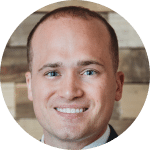
My name is Tyler Emrick, CFP®. I am writing a story about my journey since 2007 as a financial advisor. I didn’t know what I didn’t know in the beginning and am still learning today. But today I understand a lot more. My hope in sharing what I learned along the way will allow you to understand better the financial person you’re working with, including his or her incentives, and whether or not you are getting value commensurate with what you are paying.
A Fresh Start
After being a Fishbowl Financial Planner as my first entrée into the industry, I became disheartened. I stepped away from the industry for a couple of years. Yet, I yearned for a way – but a better way – back.
At this time, the Great Financial Crisis of 2008 (or GFC as it has become known in the industry) was in the rearview mirror, and firms were starting to hire again. I had a simple goal in mind – to find a company that puts customer needs first and to learn. Many nights of research and networking followed, and I eventually found myself in one of the first new hire classes after the GFC at one of the largest discount brokers in the world. (Discount broker … think of companies like Schwab, Fidelity, TD Ameritrade.)
Right from the start, this was different than my previous experience. The prior experience was solely sales training. At the new firm, before I ever spoke with the first customer, I spent months in a classroom environment learning the basics of the industry: securities trading, money transfers, account types, etc. Yes, finally relief, no more sales tactics or promoting the next best product that promises to solve all your clients’ needs … well, sort of.
I started in the service department, taking 30 to 40 calls a day handling various requests such as updating beneficiaries, making mutual fund and stock trades, and transferring money. Being a large discount broker, many customers did not live close to a brick-and-mortar branch. They also did not have a specific advisor that helped them. Rather, customers were served from the call center where I worked.
Benefiting from hard work and luck with timing, I was promoted four times within the first two years. It was an exciting time for personal and professional growth.
Frictions Emerge
Through each promotion, my responsibilities increased. By my fourth promotion, I found myself providing financial advice. Well, at least I thought it was financial advice. However, I had to make it clear to the customer that our recommendations were “educational in nature” and technically (but importantly) not advice.
The planning process was simple. I would briefly discuss their annual spending goals and project their asset values into the future. We would finish comparing their numbers and what the projection said they could afford. The whole process took 30 minutes from start to finish.
Many didn’t know how much they spent in the past or how that may change in the future. So we could only give them a rough idea of what they may be able to afford to spend. It was up to them to figure out if that was enough.
Others seemed somewhat confident about what they spent, but I didn’t have anyway – nor the knowledge at the time – to verify their data in the 30 minutes I was to spend with them.
Our suitable recommendations included a wide array of products: an investment management product for investment help and different annuities for guaranteed income.
I ended up being directly responsible for 500 – 800 customers at any given time. The customers I worked with had to have a minimum of $500,000 with the discount broker. Some had many millions.
My time was spread thin. One day I week, I had to take incoming calls only. That left 4 days for my existing customers and to take on new customers.
I was paid a base salary as a financial advisor and had significant bonuses based on a scorecard, ranking me against my peers across varying categories. The highest weighted categories centered around moving new assets to the company and using solutions such as annuities and managed investment products. Being at the top of the scorecard meant everything – higher pay, future promotions.
Having 800 customers to serve over 4 days a week and having some time to handle miscellaneous office duties, meant that I had about 1-2 hours I could spend on each customer per year at most. Factor in that I had to bring new assets from customers too, and the time was even less.
Reflections
As I reflect on my time at the discount broker, it is clear to me why we did certain things. They sold financial products. They didn’t provide advice or have personal relationships with their clients. It was vital for them to keep things simple and not delve into the complex. Complex requires time and expertise. Relationships take time too and are not scalable.
The planning we provided was a sufficient start for anyone who has never thought through their future but fell well short of what I would later know as financial planning.
As my knowledge and expertise increased, the holes in this process became abundantly clear:
Why did we have to make a distinction between advice and education? Shouldn’t your advisor be required (legally) to give the best advice possible?
Was a one-time 30-minute meeting sufficient to plan a customer’s financial life forever? And do it with one hand tied behind my back, not taking into consideration tax planning?
The headwinds were too strong – too many customers and too little time – I was not putting myself or the people I worked within a position to be as successful as they deserved to be. Rather than having “customers” — a person who purchases goods and services — depth to the relationship was needed to have “clients” — someone who receives professional services and develops a personal relationship.
I was no longer in the fishbowl and life for me and my customers were better but still fell short. I needed a change and wanted to do more. I deserved it, and so did the individuals and families that worked with me.



